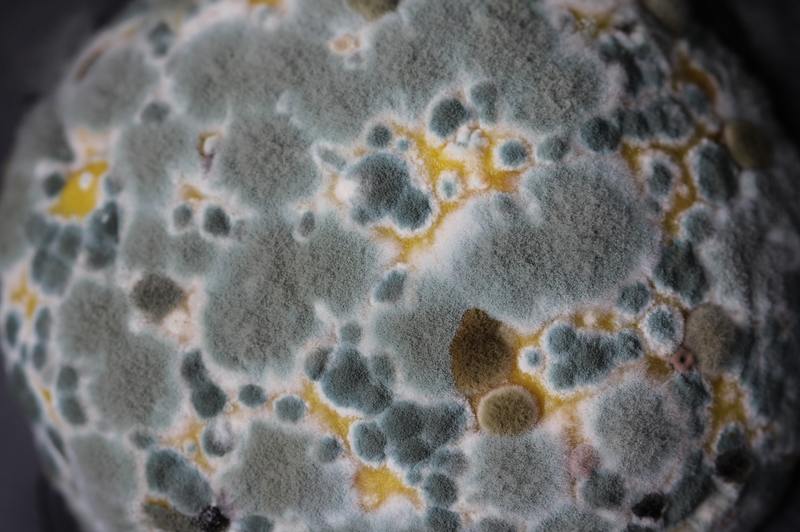In this article, you will learn where does penicillium mold grow. It grows both indoors and outdoors, but we’ll get to the specifics later.
If this is interesting to you, be sure to read this article about penicillium mold growth until the end!

What Is Penicillium Mold?
The Penicillium genus has over 300 species; some of them are common while others aren’t. Penicillium mold has a broad range of colors.
Some of the colors of its colonies are white, blue-green, pink, and yellow, but they are commonly known as blue or green molds. As with other types of mold, they grow and spread quickly.
Typically, color is how people differentiate mold from one another. Here’s an article outlining how to detect mold through color.
Another thing you need to know about penicillium mold is that it’s different from penicillin. The latter has health benefits while the former pose adverse health effects.
Where can you find penicillium mold?
Like with other types of mold, Penicillium mold spores can be found everywhere because they are airborne. They settle on various surfaces ranging from outdoor soil to indoor belongings (e.g. leather, clothing, etc).
Specifically, penicillium grows on decaying plants, soil, grains, compost, and rotting fruit in an outdoor environment. While indoors, they also settle on carpets, wallpaper, house dust, and paint.
Penicillium mold grows when its conditions for growth are met. There are three criteria for penicillium mold growth, which are moisture, food source, and oxygen.
Oxygen is quite literally everywhere, so this condition is not difficult to meet. Food source and moisture are the last ones to be fulfilled before mold contamination.
Are they dangerous?
All forms of mold pose adverse health effects, and Penicillium mold is no different. This is because penicillium has a species that produces mycotoxins, which exude toxic compounds.
Penicillium also grows on food. When ingested, they can cause stomach upset.
Here is an article about accidentally ingesting mold if you want to know more about it. Apart from stomach upset, mold can cause allergies.
The allergies can be respiratory or integumentary. If your family members have asthma, they may get triggered or develop severe reactions when exposed to mold.
Knowing the health effects of mold should make you more cautious of it. One way of exercising caution is to compare the indoor and outdoor air samples.
If there is little to no difference in the number of spores, then you’re safe. However, it should be addressed immediately if your indoor air sample has more spores than the outdoor air sample.
Professionals best do this air quality check, so if you wish to have your air components tested for penicillium mold spores, go for it!
Despite its health effects, some types of penicillium are beneficial for us humans as well. Penicillium is used to create cheeses like Brie, Camembert, and Roquefort.
These cheeses are naturally safe to eat unless it’s past their expiration date. The drug penicillin is also helpful for humans.
However, do remember that not all typical mold growth in a household is not safe. The ones used for food and medicine undergo several processes before they become non-toxic and edible.
What to do when there is mold growth in your home?
Step #1. First, identify the type of mold growth in your home. Also, look into the cause of mold contamination.
However, it is most likely water damage, so get to the bottom of the water damage and fix it. You can opt to call a professional for this concern as well.
Step #2. If the contaminated area is not significant, start cleaning the mold off the surface. When you do so, don protective equipment.
The equipment you need for cleaning mold is a respiratory mask, safety goggles, and a pair of gloves. You have the choice to wear a full-body suit or an old long-sleeved shirt to protect your skin from mold exposure.
Step #3. Use a mold-killing agent, either commercial or natural, and apply it on the mold-contaminated surface. Repeat the application until the mold stains disappear.
If the mold growth is located in an inaccessible part of your home, we recommend going to a professional instead.
Penicillium mold prevention tips
To prevent mold growth, deny molds food sources and moisture. That means you have to clean the nooks and crannies of your home regularly.
Moreover, you have to ventilate your home well. Encourage airflow in your household so the mold spores do not settle indoors.
If it’s impossible to open windows due to the season, invest in an air purifier or a dehumidifier. You can also choose to have both to ensure good air quality indoors.
If mold keeps coming back despite several cleaning and removal processes, other areas may be mold-contaminated. Therefore, it leads to continued mold growth.
In that situation, hire a professional to do a mold inspection in your home.
Conclusion
Now that you’ve learned about where does penicillium mold grow, you can avoid mold growth in those areas by following our tips. Moreover, we hope our warnings on its health effects were enough for you to exercise caution.
